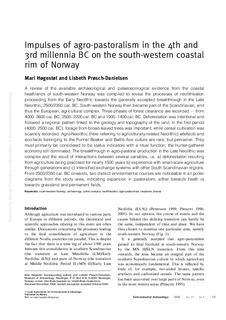| dc.contributor.author | Prøsch-Danielsen, Lisbeth | |
| dc.contributor.author | Høgestøl, Mari | |
| dc.date.accessioned | 2013-05-15T11:38:31Z | |
| dc.date.available | 2013-05-15T11:38:31Z | |
| dc.date.issued | 2006 | |
| dc.identifier.citation | Høgestøl, M. & Prøsch-Danielsen, L. (2006) Impulses of agro-pastoralism in the 4th and 3rd millennia BC on the south-western coastal rim of Norway. Environmental Archaeology, 11(1), 17-32 | no_NO |
| dc.identifier.uri | http://hdl.handle.net/11250/181539 | |
| dc.description | Made available with permission from Maney Publishing / Environmental Archaeology. www.maneypublishing.com/journals/env and www.ingentaconnect.com/content/maney/env. | no_NO |
| dc.description.abstract | A review of the available archaeological and palaeoecological evidence from the coastal
heathlands of south-western Norway was compiled to reveal the processes of neolithisation
proceeding from the Early Neolithic towards the generally accepted breakthrough in the Late
Neolithic, 2500/2350 cal. BC. South-western Norway then became part of the Scandinavian, and
thus the European, agricultural complex. Three phases of forest clearance are recorded — from
4000–3600 cal. BC, 2500–2200 cal. BC and 1900–1400 cal. BC. Deforestation was intentional and
followed a regional pattern linked to the geology and topography of the land. In the first period
(4000–2500 cal. BC), forage from broad-leaved trees was important, while cereal cultivation was
scarcely recorded. Agro-Neolithic (here referring to agriculturally-related Neolithic) artefacts and
eco-facts belonging to the Funnel Beaker and Battle Axe culture are rare, but pervasive. They
must primarily be considered to be status indicators with a ritual function; the hunter-gatherer
economy still dominated. The breakthrough in agro-pastoral production in the Late Neolithic was
complex and the result of interactions between several variables, i.e. a) deforestation resulting
from agriculture being practised for nearly 1500 years b) experience with small-scale agriculture
through generations and c) intensified exchange systems with other South Scandinavian regions.
From 2500/2350 cal. BC onwards, two distinct environmental courses are noticeable in all pollen
diagrams from the study area, indicating expansion in pastoralism, either towards heath or
towards grassland and permanent fields. | no_NO |
| dc.language.iso | eng | no_NO |
| dc.publisher | Maney Publishing | no_NO |
| dc.subject | south-western Norway | no_NO |
| dc.subject | arkeologi | no_NO |
| dc.subject | Jæren | no_NO |
| dc.subject | Norge | no_NO |
| dc.subject | pollen analysis | no_NO |
| dc.subject | neolithisation | no_NO |
| dc.subject | agro-pastoralism | no_NO |
| dc.subject | clearance phases | no_NO |
| dc.title | Impulses of agro-pastoralism in the 4th and 3rd millennia BC on the south-western coastal rim of Norway | no_NO |
| dc.type | Journal article | no_NO |
| dc.type | Peer reviewed | no_NO |
| dc.subject.nsi | VDP::Humanities: 000::Archeology: 090::Nordic archeology: 091 | no_NO |
| dc.source.pagenumber | 17-32 | no_NO |
| dc.source.volume | 11 | no_NO |
| dc.source.journal | Environmental Archaeology | no_NO |
| dc.source.issue | 1 | no_NO |
